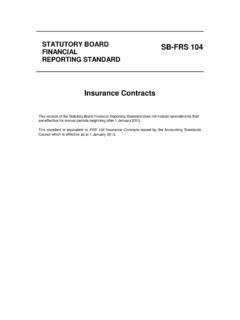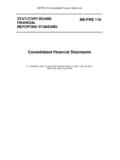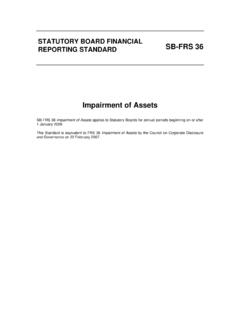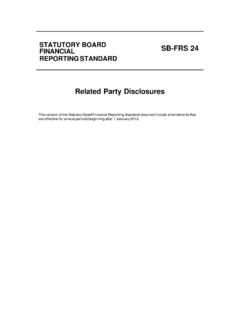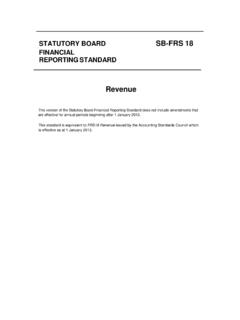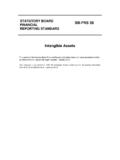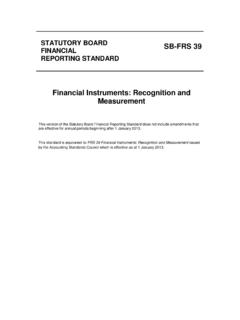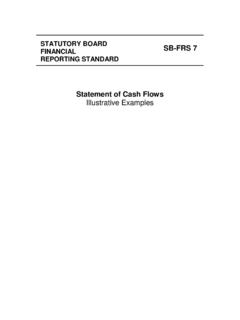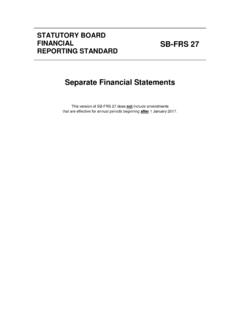Transcription of STATUTORY BOARD SB-FRS 19 FINANCIAL REPORTING …
1 Employee Benefits This standard applies for annual periods beginning on or after 1 January 2013. Earlier application is permitted STATUTORY BOARD FINANCIAL REPORTING STANDARD SB-FRS 19 SB-FRS 19 Employee Benefits 2 CONTENTS paragraphs INTRODUCTION IN1 IN8 STATUTORY BOARD FINANCIAL REPORTING STANDARD 19 EMPLOYEE BENEFITS OBJECTIVE 1 SCOPE 2 7 DEFINITIONS 8 SHORT-TERM EMPLOYEE BENEFITS 9 25 Recognition and measurement 11 24 All short-term employee benefits 11 12 Short-term paid absences 13 18 Profit-sharing and bonus plans 19 24 Disclosure 25 POST-EMPLOYMENT BENEFITS: DISTINCTION BETWEEN DEFINED CONTRIBUTION PLANS AND DEFINED BENEFIT PLANS 26 49 Multi-employer plans 32 39 Defined benefit plans that share risks between entities under common control 40 42 State plans 43 45 Insured benefits 46 49 POST-EMPLOYMENT BENEFITS: DEFINED CONTRIBUTION PLANS 50 54 Recognition and measurement 51 52 Disclosure 53 54 POST-EMPLOYMENT BENEFITS.
2 DEFINED BENEFIT PLANS 55 152 Recognition and measurement 56 60 Accounting for the constructive obligation 61 62 Statement of FINANCIAL position 63 65 Recognition and measurement: present value of defined benefit obligations and current service cost 66 98 Actuarial valuation method 67 69 Attributing benefit to periods of service 70 74 Actuarial assumptions 75 80 Actuarial assumptions: mortality 81 82 Actuarial assumptions: discount rate 83 86 SB-FRS 19 Employee Benefits 3 Actuarial assumptions: salaries, benefits and medical costs 87 98 Past service cost and gains and losses on settlement 99 112 Past service cost 102 108 Gains and losses on settlement 109 112 Recognition and measurement: plan assets 113 119 Fair value of plan assets 113 115 Reimbursements 116 119 Components of defined benefit cost 120 130 Net interest on the net defined benefit liability (asset) 123 126 Remeasurements of the net defined benefit liability (asset)
3 127 130 Presentation 131 134 Offset 131 132 Current/non-current distinction 133 Components of defined benefit cost 134 Disclosure 135 152 Characteristics of defined benefit plans and risks associated with them 139 Explanation of amounts in the FINANCIAL statements 140 144 Amount, timing and uncertainty of future cash flows 145 147 Multi-employer plans 148 Defined benefit plans that share risks between entities under common control 149 150 Disclosure requirements in other SB-FRSs 151 152 OTHER LONG-TERM EMPLOYEE BENEFITS 153 158 Recognition and measurement 155 157 Disclosure 158 TERMINATION BENEFITS 159 171 Recognition 165 168 Measurement 169 170 Disclosure 171 TRANSITION AND EFFECTIVE DATE 172 173 APPENDIX Amendments to other SB-FRSs AMENDMENTS TO GUIDANCE ON OTHER SB-FRSs TABLE OF CONCORDANCE FRS 19 Employee Benefits 4 STATUTORY BOARD FINANCIAL REPORTING Standard 19 Employee Benefits ( SB-FRS 19) is set out in paragraphs 1 173 and the Appendix.
4 All the paragraphs have equal authority. SB-FRS 19 should be read in the context of its objective, the Preface to STATUTORY BOARD FINANCIAL REPORTING Standards and the Conceptual Framework for FINANCIAL REPORTING . SB-FRS 8 Accounting Policies, Changes in Accounting Estimates and Errors provides a basis for selecting and applying accounting policies in the absence of explicit guidance. SB-FRS 19 Employee Benefits 5 Introduction IN1 SB-FRS 19 Employee Benefits prescribes the accounting and disclosure by employers for employee benefits. The Standard does not deal with REPORTING by employee benefit plans (see SB-FRS 26 Accounting and REPORTING by Retirement Benefit Plans). IN2 The Standard identifies four categories of employee benefits: (a) short-term employee benefits, such as the following (if expected to be settled wholly before twelve months after the end of the annual REPORTING period in which the employees render the related services): wages, salaries and social security contributions, paid annual leave and paid sick leave, profit-sharing and bonuses and non-monetary benefits (such as medical care, housing, cars and free or subsidised goods or services) for current employees; (b) post-employment benefits such as retirement benefits (eg pensions and lump sum payments on retirement), post-employment life insurance and post-employment medical care; (c) other long-term employee benefits, such as long-service leave or sabbatical leave, jubilee or other long-service benefits, long-term disability benefits.
5 And (d) termination benefits. IN3 The Standard requires an entity to recognise short-term employee benefits when an employee has rendered service in exchange for those benefits. IN4 Post-employment benefit plans are classified as either defined contribution plans or defined benefit plans. The Standard gives specific guidance on the classification of multi-employer plans, state plans and plans with insured benefits. IN5 Under defined contribution plans, an entity pays fixed contributions into a separate entity (a fund) and will have no legal or constructive obligation to pay further contributions if the fund does not hold sufficient assets to pay all employee benefits relating to employee service in the current and prior periods. The Standard requires an entity to recognise contributions to a defined contribution plan when an employee has rendered service in exchange for those contributions.
6 SB-FRS 19 Employee Benefits 6 IN6 All other post-employment benefit plans are defined benefit plans. Defined benefit plans may be unfunded, or they may be wholly or partly funded. The Standard requires an entity: (a) to account not only for its legal obligation, but also for any constructive obligation that arises from the entity s practices. (b) to determine the present value of defined benefit obligations and the fair value of any plan assets with sufficient regularity that the amounts recognised in the FINANCIAL statements do not differ materially from the amounts that would be determined at the end of the REPORTING period. (c) to use the projected unit credit method to measure its obligations and costs. (d) to attribute benefit to periods of service under the plan s benefit formula, unless an employee s service in later years will lead to a materially higher level of benefit than in earlier years.
7 (e) to use unbiased and mutually compatible actuarial assumptions about demographic variables (such as employee turnover and mortality) and FINANCIAL variables (such as future increases in salaries, changes in medical costs and particular changes in state benefits). FINANCIAL assumptions should be based on market expectations, at the end of the REPORTING period, for the period over which the obligations are to be settled. (f) to determine the discount rate by reference to market yields at the end of the REPORTING period on high quality corporate bonds (or, in countries where there is no deep market in such bonds, government bonds) of a currency and term consistent with the currency and term of the post-employment benefit obligations. (g) to deduct the fair value of any plan assets from the carrying amount of the obligation in order to determine the net defined benefit liability (asset).
8 Some reimbursement rights that do not qualify as plan assets are treated in the same way as plan assets, except that they are presented as a separate asset, rather than as a deduction from the obligation. (h) to limit the carrying amount of a net defined benefit asset so that it does not exceed the economic benefits available in the form of refunds from the plan or reductions in future contributions to the plan. (i) to recognise all changes in the net defined benefit liability (asset) when they occur, as follows: (i) service cost and net interest in profit or loss; and (ii) remeasurements in other comprehensive income. SB-FRS 19 Employee Benefits 7 IN7 Employee benefits other than short-term employee benefits, post-employment benefits and termination benefits are other long-term employee benefits. For other long-term employee benefits, the Standard requires the same recognition and measurement as for post-employment benefits but all changes in the carrying amount of liabilities for other long-term employment benefits are recognised in profit or loss.
9 The Standard does not require specific disclosures about other long-term employee benefits. IN8 Termination benefits are employee benefits payable as a result of either an entity s decision to terminate an employee s employment before the normal retirement date or an employee s decision to accept an offer of benefits in exchange for the termination of employment. An entity is required to recognise termination benefits at the earlier of when the entity can no longer withdraw an offer of those benefits and when it recognises any related restructuring costs. SB-FRS 19 Employee Benefits 8 STATUTORY BOARD FINANCIAL REPORTING Standard 19 Employee Benefits Objective 1 The objective of this Standard is to prescribe the accounting and disclosure for employee benefits. The Standard requires an entity to recognise: (a) a liability when an employee has provided service in exchange for employee benefits to be paid in the future; and (b) an expense when the entity consumes the economic benefit arising from service provided by an employee in exchange for employee benefits.
10 Scope 2 This Standard shall be applied by an employer in accounting for all employee benefits, except those to which SB-FRS 102 Share-based Payment applies. 3 This Standard does not deal with REPORTING by employee benefit plans (see SB-FRS 26 Accounting and REPORTING by Retirement Benefit Plans). 4 The employee benefits to which this Standard applies include those provided: (a) under formal plans or other formal agreements between an entity and individual employees, groups of employees or their representatives; (b) under legislative requirements, or through industry arrangements, whereby entities are required to contribute to national, state, industry or other multi-employer plans; or (c) by those informal practices that give rise to a constructive obligation. Informal practices give rise to a constructive obligation where the entity has no realistic alternative but to pay employee benefits.
